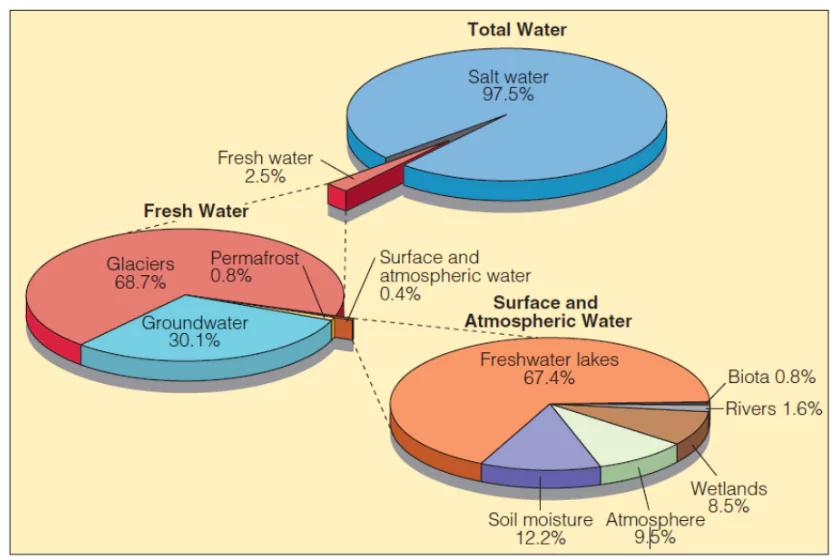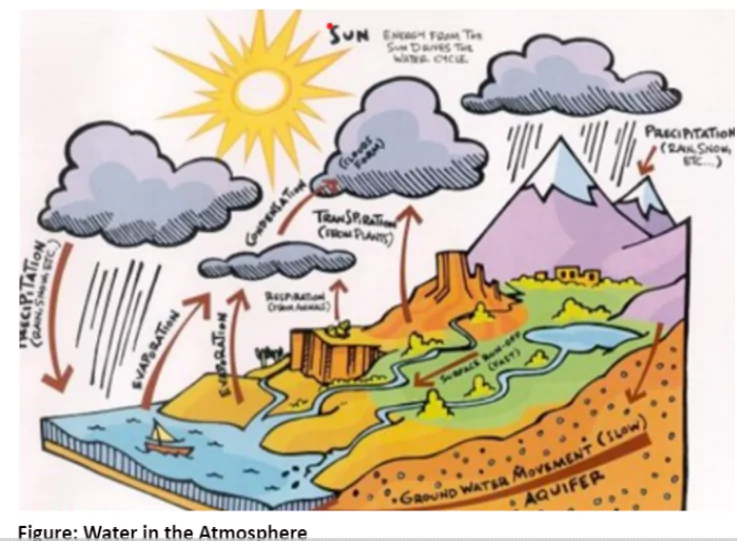Water exists in the air in three forms: gas, liquid, and solid, contributing to weather patterns. It comes from evaporation of water bodies and plants. The amount of water vapour in the air is called humidity, with absolute humidity measuring the actual amount and relative humidity comparing it to the air’s capacity at a specific temperature. Saturated air can’t hold more moisture, marked by the dew point temperature.
Hydrological Cycle

- The continuous transformation and circulation of water among oceans, the atmosphere, and land is referred to as the water or hydrological cycle.
- Distribution of water in percentage:
- Oceans: 97.3;
- Ice-caps: 2.0;
- Ground Water: 0.68;
- Freshwater Lakes: 0.009;
- Inland Seas & Salt Lakes: 0.009;
- Atmosphere: 0.0019;
- Rivers: 0.0001 [UPSC 2021]
- The below table shows the conversion process of water in the atmosphere.
Enroll now for UPSC Online Course
| Process |
Meaning |
| Condensation |
- Process of converting vapour into liquid or solid
|
| Transpiration |
- Water is released into the atmosphere from plant leaves. Plants lose more than 90 per cent of their water through transpiration
|
| Evaporation |
- The process of converting liquid into vapor at a temperature below its boiling point.
|
| Precipitation |
- The process of water returning from the atmosphere to the land as precipitation, including rain, snow, sleet, and other forms.
|
Humidity
Water vapour present in the air is known as humidity.
- Absolute Humidity: The actual amount of water vapour present in the atmosphere; represents the mass of water vapour per unit volume of air;
- Measured in grams per cubic meter. It depends entirely on the temperature of the air (Greater over the ocean and less over the continent).
- Relative Humidity: Percentage of moisture present in the atmosphere as compared to its full capacity at a given temperature.
- Specific Humidity: It is the mass of water vapour per unit mass of air.
- It is preferred over absolute humidity as it doesn’t change with changes in the condition of temperature & pressure.
- Saturated Air (100% RH): Holds maximum moisture at that temperature; any moisture in excess causes condensation.
- Saturation is achieved by raising absolute humidity (adding moisture) or lowering temperature.
- Unsaturated Air (<100% RH): Holds moisture below max capacity; can absorb more without saturation.
- Dew Point: The temperature at which saturation occurs in a given sample of air.
Clouds
- Formation of Clouds: Clouds are made of tiny water droplets or ice crystals formed by condensation in the atmosphere.
- Weather Impact of Clouds: They impact weather by cooling (reflecting sunlight) and warming (trapping heat).
- Types: There are four main types: Cirrus (high, thin, icy), Nimbus (dark, shapeless, sun-blocking), Stratus (layered, covering large areas), and Cumulus (cotton-like, flat base).
 Formation of Various Cloud Types: These types can combine to form high, middle, low, or vertically developed clouds.
Formation of Various Cloud Types: These types can combine to form high, middle, low, or vertically developed clouds.-
- Example: Cirrus, cirrostratus, Altostratus, Stratocumulus, cumulonimbus
Precipitation
- Precipitation is the release of moisture resulting from water vapour condensation. It includes rainfall (liquid water), snowfall (frozen water crystals), sleet (frozen raindrops), hailstones (ice pellets), freezing rain (frozen drizzle), and virga (evaporating raindrops).
- Types of Rainfall
- Convectional Rainfall: Warm air rises, cools, and condenses, common in equatorial and continental regions.
- Orographic Rainfall (Relief Rainfall): Moist air encounters mountains, rises, cools, and condenses, creating rain and dry areas (rain-shadow).
- Cyclonic Rainfall: Associated with weather fronts and cyclones, occurring globally.
- World Distribution of Rainfall
- Equatorial regions receive consistent rainfall.
- Coastal areas and regions between 35° and 40° N and S receive heavier rainfall.
- Polar and Inland: Rainfall diminishes towards the poles and inland areas.
- Regions with heavy, moderate, inadequate, and low rainfall are distributed accordingly.
Evaporation
- Transformation of water from liquid to gas.
- Influenced by temperature, air movement, and moisture content.
- Evaporation rates vary globally, with oceans having higher rates.
Condensation
- Conversion of water vapor into liquid or solid.
- Influenced by temperature, humidity, air movement, and condensation nuclei.
- Forms include dew, fog, clouds, frost, snow, and hailstones.
- Fog: Cloud forming near or on Earth’s surface due to temperature drops.
- Types include radiation, advection, upslope, and steam fog.
- Mist: It is denser than fog and occurs in moist air.
- Smog: Mixture of smoke and fog, caused by urban or industrial pollution.
- Types include classical (coal combustion), photochemical (sunlight reaction), and volcanic smog.
Enroll now for UPSC Online Classes
Conclusion
- Water in the atmosphere plays a vital role in the hydrological cycle, with processes like evaporation and condensation shaping weather patterns.
- Cloud formation and precipitation contribute to the distribution of water across the Earth. Understanding these processes helps us comprehend and predict weather phenomena, crucial for various aspects of life and the environment.
![]() April 29, 2024
April 29, 2024
![]() 2646
2646
![]() 0
0

 Formation of Various Cloud Types: These types can combine to form high, middle, low, or vertically developed clouds.
Formation of Various Cloud Types: These types can combine to form high, middle, low, or vertically developed clouds.